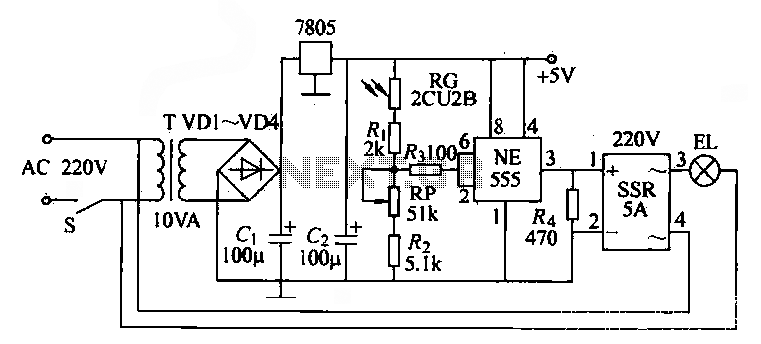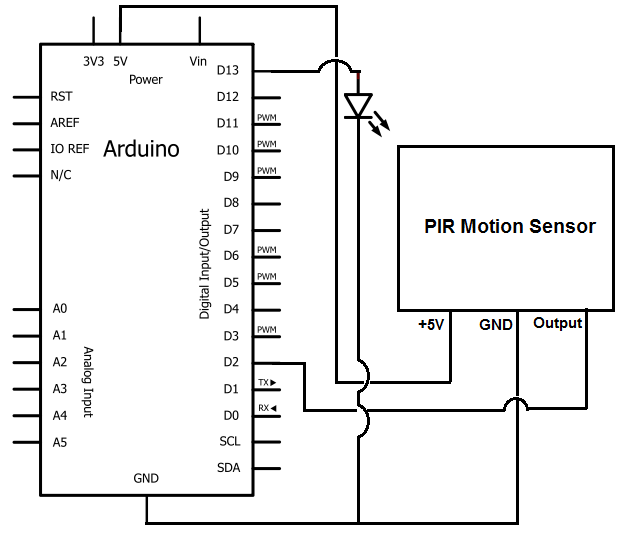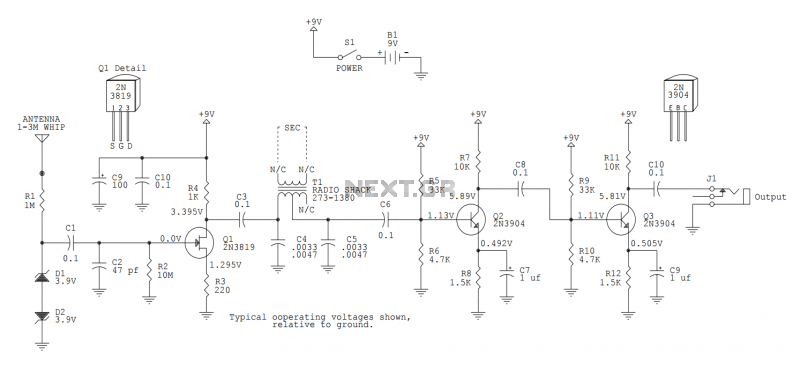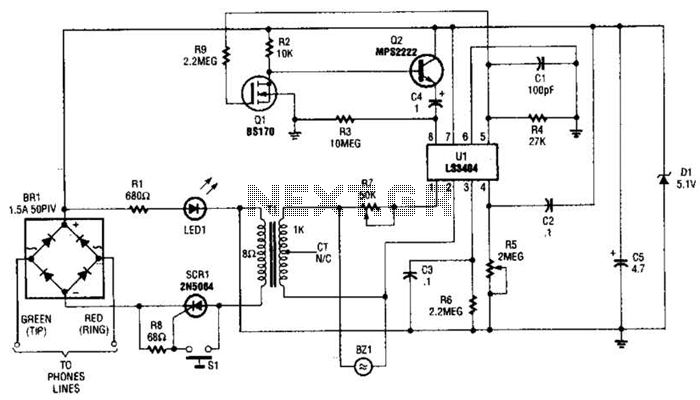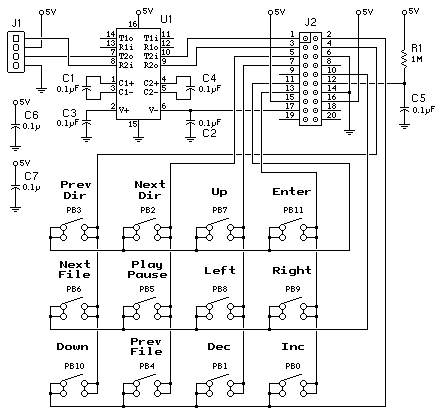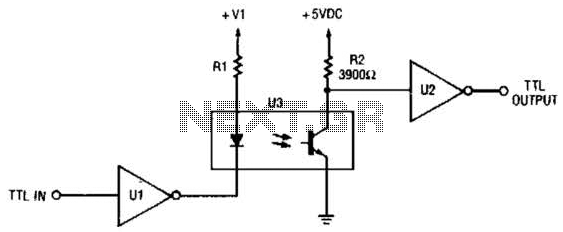
Electromagnetic Ring Launcher Circuit
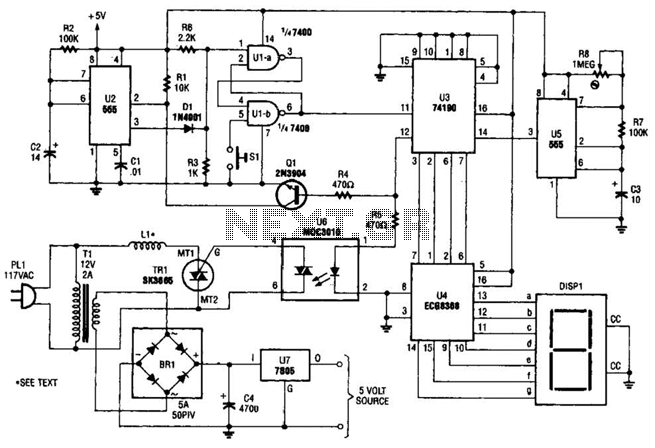
The electromagnetic ring launcher consists of four subcircuits: a clock circuit utilizing U5, a 555 oscillator/timer configured for astable operation; a countdown/display circuit incorporating U3, a 74190 synchronous up/down counter with BCD outputs set for countdown operation; U4, an ECG8368 BCD-to-7-segment latch/decoder/display driver; and DISP1, a common-cathode seven-segment display. Additionally, there is a trigger circuit made up of U6, an MOC3010 optoisolator/coupler with a Triac-driver output; TR1, an SK3665 200-PIV, 4-A Triac; and several supporting components. A reset circuit is also included, consisting of U1, a 7400 quad 2-input NAND gate; U2, a second 555 oscillator/timer configured for monostable operation; and various support components. This circuit operates a repulsion coil (L1) designed to demonstrate the principle of electromagnetic repulsion by propelling a metal ring through the air around the core of L1. A countdown circuit is integrated to count seconds prior to launch.
The electromagnetic ring launcher circuit is a sophisticated assembly designed to illustrate the principles of electromagnetic propulsion. The clock circuit, centered around the U5 component, operates as an astable multivibrator, generating a continuous square wave signal. This signal serves as the timing reference for the subsequent subcircuits. The countdown/display circuit is critical for user interaction, featuring the U3 synchronous up/down counter, which counts down from a preset number of seconds to launch. Its BCD outputs are processed by the U4 ECG8368, which converts the binary-coded decimal data into a format suitable for display on the common-cathode seven-segment display (DISP1).
The trigger circuit is essential for initiating the launch sequence. It utilizes the MOC3010 optoisolator to safely isolate the control logic from the high-power components. The output of the optoisolator drives the TR1 Triac, which handles the high current required to energize the repulsion coil (L1). The repulsion coil generates a magnetic field that interacts with the metal ring, creating a force that propels the ring along its path.
The reset circuit is designed to ensure that the system can be easily reset between launches. It employs the U1 NAND gate to manage the reset logic, while U2 acts as a monostable timer, providing a controlled pulse to reset the countdown and prepare the system for the next launch sequence. The integration of these components allows for a smooth operation, demonstrating the principles of electromagnetic repulsion effectively. Overall, the design emphasizes safety, functionality, and user interaction, making it an educational tool for understanding electromagnetic principles. The electromagnetic ring launcher is comprised of.four subcircuits: a clock circuit (built around U5, a 555 oscillator/timer configured for astable operation), a count-down/display circuit (built around U3), a 74190 synchronous up/down counter with BCD outputs that is configured for countdown operation; U4, a ECG8368 BCD-to-7-segment latch/decoder/display driver; and DISP1, a common-cathode seven-segment display), a trigger circuit (comprised of U6), an MOC3010 optoisolator/ coupler with Triac-driver output; TR1, an SK3665 200-PIV, 4-A Triac; and a few support components), and a reset circuit (comprised of Ul, a 7400 quad 2-input NAND gate; U2, a second 555 oscillator/timer configured for monostable operation; and a few support components). This circuit is that of a repulsion coil (LI) used to demonstrate the principle of electromagnetic repulsion by propelling a metal ring around the core of LI through the air.
A countdown circuit is provided to count seconds before launch. 🔗 External reference
The electromagnetic ring launcher circuit is a sophisticated assembly designed to illustrate the principles of electromagnetic propulsion. The clock circuit, centered around the U5 component, operates as an astable multivibrator, generating a continuous square wave signal. This signal serves as the timing reference for the subsequent subcircuits. The countdown/display circuit is critical for user interaction, featuring the U3 synchronous up/down counter, which counts down from a preset number of seconds to launch. Its BCD outputs are processed by the U4 ECG8368, which converts the binary-coded decimal data into a format suitable for display on the common-cathode seven-segment display (DISP1).
The trigger circuit is essential for initiating the launch sequence. It utilizes the MOC3010 optoisolator to safely isolate the control logic from the high-power components. The output of the optoisolator drives the TR1 Triac, which handles the high current required to energize the repulsion coil (L1). The repulsion coil generates a magnetic field that interacts with the metal ring, creating a force that propels the ring along its path.
The reset circuit is designed to ensure that the system can be easily reset between launches. It employs the U1 NAND gate to manage the reset logic, while U2 acts as a monostable timer, providing a controlled pulse to reset the countdown and prepare the system for the next launch sequence. The integration of these components allows for a smooth operation, demonstrating the principles of electromagnetic repulsion effectively. Overall, the design emphasizes safety, functionality, and user interaction, making it an educational tool for understanding electromagnetic principles. The electromagnetic ring launcher is comprised of.four subcircuits: a clock circuit (built around U5, a 555 oscillator/timer configured for astable operation), a count-down/display circuit (built around U3), a 74190 synchronous up/down counter with BCD outputs that is configured for countdown operation; U4, a ECG8368 BCD-to-7-segment latch/decoder/display driver; and DISP1, a common-cathode seven-segment display), a trigger circuit (comprised of U6), an MOC3010 optoisolator/ coupler with Triac-driver output; TR1, an SK3665 200-PIV, 4-A Triac; and a few support components), and a reset circuit (comprised of Ul, a 7400 quad 2-input NAND gate; U2, a second 555 oscillator/timer configured for monostable operation; and a few support components). This circuit is that of a repulsion coil (LI) used to demonstrate the principle of electromagnetic repulsion by propelling a metal ring around the core of LI through the air.
A countdown circuit is provided to count seconds before launch. 🔗 External reference
